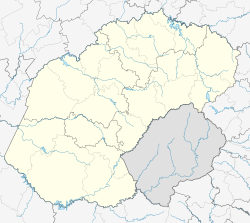Hobhouse, Free State
| Hobhouse | |
|---|---|

Hobhouse, Dutch Reformed Church
|
|
|
|
|
| Coordinates: 29°32′S 27°09′E / 29.533°S 27.150°ECoordinates: 29°32′S 27°09′E / 29.533°S 27.150°E | |
| Country | South Africa |
| Province | Free State |
| District | Thabo Mofutsanyane |
| Municipality | Mantsopa |
| Established | 1912 |
| Area | |
| • Total | 12.6 km2 (4.9 sq mi) |
| Population (2011) | |
| • Total | 3,980 |
| • Density | 320/km2 (820/sq mi) |
| Racial makeup (2011) | |
| • Black African | 94.5% |
| • Coloured | 2.1% |
| • Indian/Asian | 0.4% |
| • White | 2.8% |
| • Other | 0.2% |
| First languages (2011) | |
| • Sotho | 91.7% |
| • Afrikaans | 3.9% |
| • English | 1.7% |
| • Sign language | 1.4% |
| • Other | 1.3% |
| Postal code (street) | 9740 |
| PO box | 9740 |
| Area code | 051 |
Hobhouse is a small farming town in the Free State province of South Africa, named after welfare campaigner Emily Hobhouse. Maize, wheat, cheese and are produced here.
Town 32 km north-east of Wepener and 51 km south-west of Ladybrand, near the Lesotho border. It was laid out on the farm Poortjie in 1912 and attained municipal status in 1913. Named after Emily Hobhouse (1860-1926), author and philanthropist who brought to public notice abuses in concentration camps during the Anglo-Boer War.
...
Wikipedia



